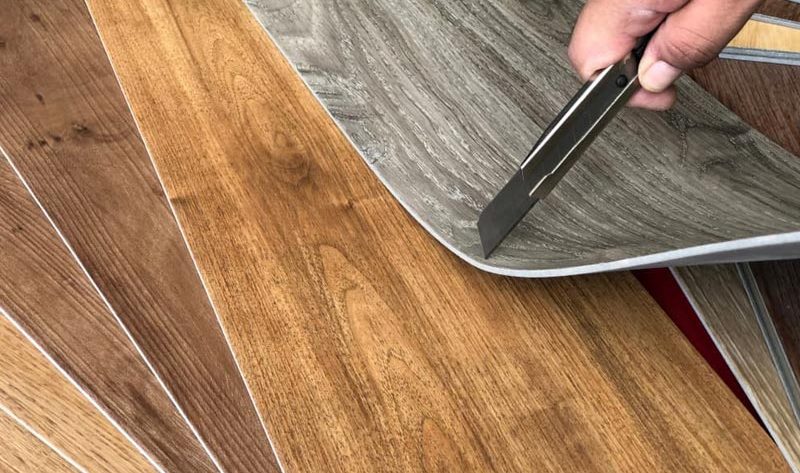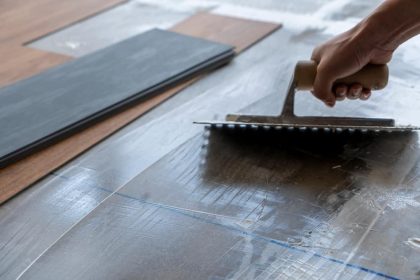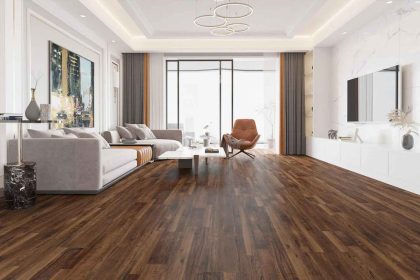Written by John Walters, Flooring Expert at The Rouse Home
Vinyl flooring has come a long way. Once seen as just a budget pick, it’s now a $25.4 billion global industry—and still growing, with a projected 5.5% annual increase through 2030 (source). Today’s vinyl blends style, strength, and simplicity—making it a favorite in modern homes. But let’s face it: when you start shopping, it can feel like a vinyl jungle. What’s the difference between LVP, LVT, and Sheet Vinyl?
Let’s break it down one step at a time.
What Is Vinyl Flooring, Anyway?
Vinyl flooring is a multi-layer synthetic flooring option designed to mimic natural surfaces like wood or stone—but without the fuss. At its core, vinyl is made of PVC (polyvinyl chloride), which gives it flexibility, water resistance, and strength. Before installation, proper surface prep is key—see our guide on how to prepare your subfloor for vinyl flooring for best results. It’s often reinforced with backing layers for stability and a wear layer to handle foot traffic, spills, pets, and everyday messes.
Why people love vinyl floors:
- They’re 100% waterproof—perfect for kitchens, bathrooms, and laundry rooms
- Super easy to clean—no waxing, no sealing, no stress
- Comfortable underfoot—no cold tiles or echoey laminate sounds
- Designed to last for years—even in high-traffic homes
You’ll find three popular vinyl types on the market, each built for different spaces, styles, and skill levels.
- Luxury Vinyl Plank (LVP)
- Luxury Vinyl Tile (LVT)
- Sheet Vinyl
Each has its sweet spot—let’s walk through what sets them apart.
1. Luxury Vinyl Plank (LVP)

Looks like: Hardwood floors
Best for: Living rooms, kitchens, hallways, and finished basements
LVP is the go-to for anyone who loves the look of real wood—oak, walnut, hickory, you name it. For a deeper dive into finishes, durability, and real home examples, check out our full breakdown on LVP flooring options.
These planks come with printed grain patterns and textured surfaces that look impressively real. Most use a click-lock system that makes installation a breeze (no nails or glue required).
If you’re planning to DIY, you’ll love how simple it is to get started. Here’s a quick guide on how to install vinyl flooring step by step—even over tile or concrete.
Standout features:
- Waterproof and scratch-resistant—Shaw Floors specifically markets their luxury vinyl as 100% waterproof and pet-friendly, making it ideal for active households (https://shawfloors.com/en-us/vinyl-overview)
- Softer and warmer than tile or laminate
- Can be installed over existing floors, including tile and concrete
♂️ On the job insight: I once installed LVP for a family of five with two golden retrievers—it’s been three years and not a single scratch or stain. If you want a floor that works hard and still looks sharp, LVP delivers.
Still torn between vinyl plank and laminate? This head-to-head comparison breaks it down—from water resistance to installation ease.
2. Luxury Vinyl Tile (LVT)
Looks like: Stone, ceramic, or porcelain tile
Best for: Bathrooms, mudrooms, foyers, and utility spaces
LVT gives you that cool, elegant tile look—without the cold tile feel. It’s thicker and more rigid than sheet vinyl, but easier to handle than actual stone. Most versions don’t need grout, which is a bonus if you hate scrubbing lines.
Why it shines:
- Mimics marble, slate, travertine, and more
- Easier to install and maintain than real tile
- Warmer underfoot—no more freezing bathroom floors in winter
- Safer for toddlers, older adults, or anyone worried about slips
Real-world example: One of my clients had aging parents move in. We swapped out the slippery ceramic floor in the bathroom with LVT. It looked like stone but gave them better grip—and peace of mind.
3. Sheet Vinyl

Looks like: One continuous surface—stone, wood, or tile pattern
Best for: Rental properties, laundry rooms, large bathrooms, and budget makeovers
Sheet vinyl is the old-school cousin in the vinyl family—but don’t count it out. Modern versions look fantastic and offer unbeatable value. Because it rolls out in wide sheets, there are fewer seams, which means fewer places for water to sneak in.
Why it works well:
- Excellent water resistance (great for bathrooms or kids’ splash zones)
- Quick to install in square or rectangular rooms
- Most affordable vinyl option—perfect for rental updates or budget remodels
✂️ Quick tip: Cutting sheet vinyl neatly takes some skill. Always use a new blade, and if you’re nervous, practice a few test cuts first.
Still Not Sure Which to Pick?
Here’s a handy side-by-side to help you compare:
| Feature | LVP | LVT | Sheet Vinyl |
|---|---|---|---|
| Look | Woodgrain | Tile or Stone | Any (wood, stone, tile) |
| Install Method | Click-lock, floating floor | Click-lock or glue-down | Glue-down roll |
| Best For | Kitchens, hallways, bedrooms | Bathrooms, mudrooms, laundry | Large simple rooms, rentals |
| Water Resistance | Excellent | Excellent | Excellent (minimal seams) |
| DIY Friendly? | Very easy | Easy to moderate | Moderate (cutting required) |
So, which vinyl is right for you?
- Want that warm wood look with easy installation? Go for LVP.
- Dreaming of sleek stone tiles that don’t freeze your feet? Choose LVT.
- Need a budget-friendly, water-resistant solution that covers large spaces fast? Sheet vinyl is your winner.
At the end of the day, all three types deliver on style and durability—just be sure to care for your vinyl properly so it stays looking sharp for years to come. And remember: if you’re still unsure, don’t hesitate to ask. I’ve helped hundreds of homeowners across the USA find their perfect floor, and I’m happy to help you make the right call too.




